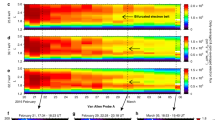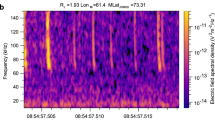Abstract
MORPHOLOGICAL characteristics of ELF emissions (frequency 2–3 kHz) observed at a low latitude ground station of Moshiri in Japan (geomag. lat. 34.5°N; L = 1.59) are reported here. ELF emissions in this frequency range are most poorly understood in the magnetospheric wave phenomena, and the information obtained on the ground will be of crucial importance in the study of their generation and propagation mechanisms. We have been observing VLF and ELF emissions at Moshiri1–3 since 1964. We believe that Moshiri is at a lower latitude than any other where the emissions are continuously recorded4. Emissions of the hiss type are measured, by the minimum detection method1, at four specific frequencies of 8 (Δƒ = ±1.25 kHz), 5 (±1 kHz), 1.5 (±.1 kHz) and 0.8 (±0.1 kHz) kHz, and recorded on paper charts. Wide band (0–10 kHz) observations on magnetic tapes have also been conducted following the synoptic schedule of two minutes every hour. We have found, using Ariel 3 VLF data, that the storm-time VLF emissions at Moshiri are generated around the plasmapause by the electron cyclotron instability with ring current electrons5. But the large number of VLF emissions appearing during magnetically quiet times have not been well studied2. Satellite measurements made on board Pogo (I. Kimura, personal communication) and Isis6 have yielded a new type of ELF emissions (ƒ < 3 kHz).
This is a preview of subscription content, access via your institution
Access options
Subscribe to this journal
Receive 51 print issues and online access
$199.00 per year
only $3.90 per issue
Buy this article
- Purchase on Springer Link
- Instant access to full article PDF
Prices may be subject to local taxes which are calculated during checkout
Similar content being viewed by others
References
Iwai, A., Outsu, J. & Tanaka, Y. Proc. res. Inst. Atmos. 11, 29–40 (1964).
Tanaka, Y., Hayakawa, M. & Ohtsu, J. Rep. ionosph. Space Res. 28, 168–172 (1974).
Hayakawa, M., Tanaka, Y. & Ohtsu, J. J. atmos. Terr. Phys. 37, 517–529 (1975).
Jørgensen, T. S. J. geophys. Res. 71, 1367–1375 (1966).
Hayakawa, M., Bullough, K. & Kaiser, T. R. Planet. Space Sci. 25, 353–368 (1977).
Ondoh, T., Aikyo, K. & Nagayama, M. J. Radio Res. Labs. Jap. 19, 23–51 (1972).
Helliwell, R. A., Katsufrakis, J. P., Bell, T. F. & Raghuram, R. J. geophys. Res. 80, 4249–4258 (1975).
Bullough, K., Tatnall, A. R. L. & Denby, M. Nature 260, 401–403 (1976).
Iwai, A. & Tanaka, Y. Proc. res. Inst. Atmos. 15, 1–16 (1968).
Outsu, J. Proc. res. Inst. Atmos. 7, 58–71 (1960).
Hayakawa, M. & Iwai, A. J. atmos. Terr. Phys. 37, 1211–1218 (1975).
Thorne, R. M., Smith, E. J., Burton, R. K. & Holzer, R. E. J. geophys. Res. 78, 1581–1596 (1973).
Thorne, R. M., Church, S. R., Malloy, W. J. & Tsurutani, B. T. J. geophys. Res. 82, 1585–1590 (1977).
Bullough, K. et al. Proc. R. Soc. Lond. A343, 207–226 (1975).
Author information
Authors and Affiliations
Rights and permissions
About this article
Cite this article
HAYAKAWA, M., TANAKA, Y. ELF emissions observed at Moshiri. Nature 270, 703–705 (1977). https://doi.org/10.1038/270703a0
Received:
Accepted:
Published:
Issue Date:
DOI: https://doi.org/10.1038/270703a0
This article is cited by
-
Observation of discrete VLF emissions at Indian low-latitude ground station Srinagar (L = 1.28)
Indian Journal of Physics (2015)
-
Drifting ELF/VLF Emissions Observed at Low Latitude Ground Station During Geomagnetic Storm
Earth, Moon, and Planets (2010)
-
Hiss emissions during quiet and disturbed periods
Pramana (2002)
Comments
By submitting a comment you agree to abide by our Terms and Community Guidelines. If you find something abusive or that does not comply with our terms or guidelines please flag it as inappropriate.



